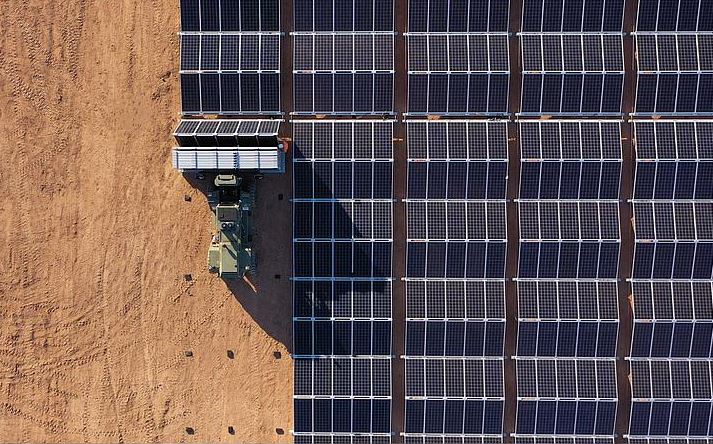Sydney-based modular solar pioneer 5B has announced a AUD 33.4 million ($24 million) tech innovation program to accelerate the delivery of “ultra low-cost solar.” The program is supported by a AUD 14 million grant from the Australian Renewable Energy Agency (ARENA).
The funding comes less than a year after 5B closed a AUD 12 million funding round, including investment support from former Australian Prime Minister Malcolm Turnbull and Smart Energy Council Director Simon Holmes à Court.
In December, 5B acquired an Adelaide manufacturing plant ahead of the global gigawatt-scale push of its rapidly deployable, modular, prefabricated Maverick solar arrays. In a statement, 5B said that its Maverick solution was already cost-competitive in Australia, as well as a number of other markets. It said that this program is designed to “leverage advanced automation to dramatically improve the scalability and cost of 5B's solution, enabling end customers to benefit from clean, solar energy at AUD 0.30 cents per watt installed by 2030.”
This ambition requires a 35% cost reduction by 2023 and a 70% cost reduction by 2030 – both targets that 5B has said it is on track to meet.
The company’s recently launched 50kW(DC) Maverick, optimized for the 550W module class, has already been installed in 52 projects in Australia, the United States, Latin America and India, for 32MW of total capacity. The Maverick arrays have proven popular with remote regions and mining operations, including a 12 MW system which it delivered with Enerven for SA Water and a 4.3 MW project it delivered with independent power provider Nomadic Energy Australia for miner Northern Star Resources in Western Australia. 5B’s Maverick system is also the preferred technology for Sun Cable’s massive 17GW to 20GW solar farm being developed in the Northern Territory, with the intent to export solar power to Singapore via a subsea transmission cable.
5B plans to use approximately two-thirds of the AUSD 33.4 million investment for the design and construction of an Advanced Manufacturing Pilot Line (AMPL). With the final third, 5B says that it will use robots to install solar arrays using GPS-guided deployment (GGD) technology. That’s right, GPS-guided solar installation robots.
It is 5B’s claim that artificial intelligence-enabled solar installation is the next frontier of solar technology, an advance that would allow for faster, cheaper, safer and more efficient solar farm construction.
“This program will drive a step change in our automation capability and enable local manufacturing in Australia,” says 5B Chief Operating Officer Nicole Kuepper-Russell. “We are grateful for ARENA’s support – investment like this is essential to realise the opportunity to build Australia’s reputation as a clean energy superpower, exporting cutting-edge clean technology to the world.”
Of course, the Australian government’s Low Emissions Technology Statement’s (LETS) stretch goal of ultra low cost solar generation at AUD 15/MWh (approximately one-third of today’s cost), means that ARENA is more than willing to fund such projects of ambition like 5B’s.
ARENA CEO Darren Miller said funding 5B would certainly help reduce the cost of solar. “While solar PV and wind are recognized as the lowest cost form of generation in Australia today, further cost reductions are required to optimise Australia’s transition to renewable electricity and to enable emerging industries such as renewable hydrogen and low emissions metals,” said Miller. “5B is an Australian success story at the forefront of solar innovation. Having started in 2013, they are now becoming leaders in locally manufactured ultra low cost solar products that could reshape our solar industry and achieve our important aim of AUD 0.30 per installed watt at utility scale by 2030.”
The news comes only a week after ARENA announced AUD 40 million in research and development funding up for grabs across two solar streams.
This content is protected by copyright and may not be reused. If you want to cooperate with us and would like to reuse some of our content, please contact: editors@pv-magazine.com.




2 comments
By submitting this form you agree to pv magazine using your data for the purposes of publishing your comment.
Your personal data will only be disclosed or otherwise transmitted to third parties for the purposes of spam filtering or if this is necessary for technical maintenance of the website. Any other transfer to third parties will not take place unless this is justified on the basis of applicable data protection regulations or if pv magazine is legally obliged to do so.
You may revoke this consent at any time with effect for the future, in which case your personal data will be deleted immediately. Otherwise, your data will be deleted if pv magazine has processed your request or the purpose of data storage is fulfilled.
Further information on data privacy can be found in our Data Protection Policy.